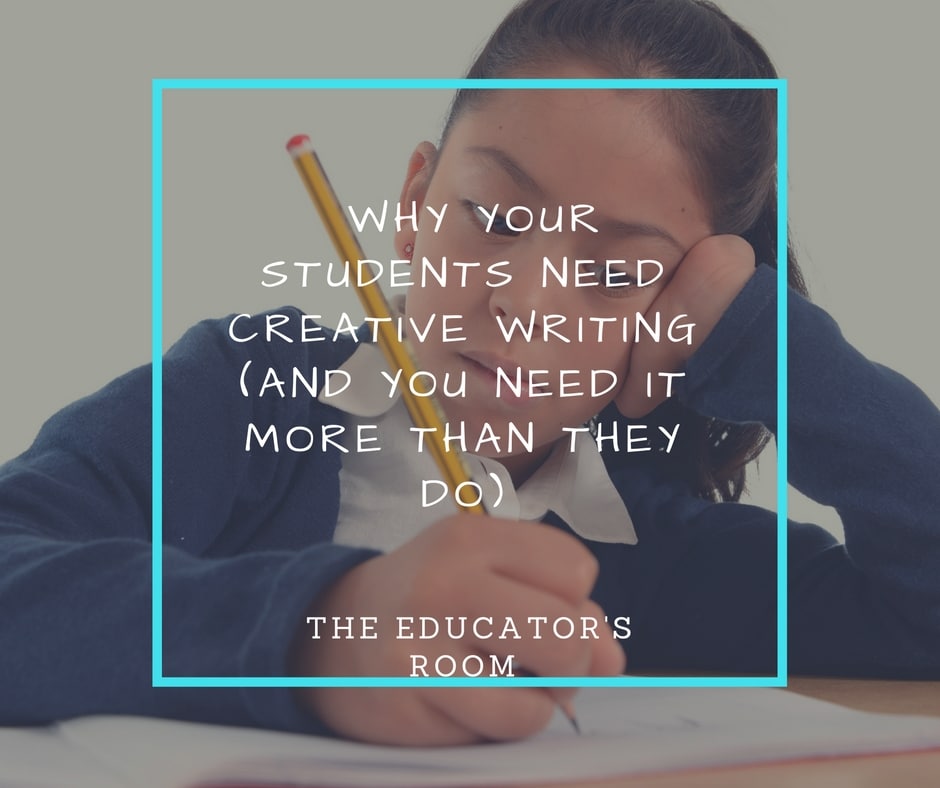I have taught the most driven, elite-college bound students, and I have taught students who barely squeaked through their graduation requirements. I have taught students for whom English was their favorite class of the day, and I have taught students who let out a big sigh every day when they walked through the door. I have taught students who could craft incredibly complex sentences using words that I barely understood, and I have taught students who struggled to write a five-sentence paragraph.
And all of them needed creative writing in their lives.
Creative writing might seem like something extra, like the unit you do at the end of the year or a class that students might take in addition to their real English class. It might seem like there isn’t time for it, especially if you are trying to fulfill common core requirements and prepare students for standardized tests, but it is necessary for all English classrooms.
Here are the reasons why you should integrate creative writing into your classes.
[fusion_builder_container hundred_percent=”yes” overflow=”visible”][fusion_builder_row][fusion_builder_column type=”1_1″ background_position=”left top” background_color=”” border_size=”” border_color=”” border_style=”solid” spacing=”yes” background_image=”” background_repeat=”no-repeat” padding=”” margin_top=”0px” margin_bottom=”0px” class=”” id=”” animation_type=”” animation_speed=”0.3″ animation_direction=”left” hide_on_mobile=”no” center_content=”no” min_height=”none”][bctt tweet=”Here are the reasons why you should integrate creative writing into your classes.” username=”EducatorsRoom”]
Students learn the craft of writing from the inside out. I have seen countless handouts and exercises that involve identifying metaphors or hyperbole. In my experience, students can do this in their sleep. Just getting them to scan for the words “like or as” doesn’t teach them anything, really. But when they struggle to find the perfect metaphor to describe the way that eating a meatball sub makes them feel, they not only identify metaphors when they see them, they will finally understand why the writer is using them.
Students learn that writing can and should be fun. I can’t even count how many students I have had who come into my class believing that writing means five-paragraph essays and nothing else. It’s no wonder that they hate to write—and that their writing is boring and pretty miserable to grade. But if they can experience a few minutes of joy at writing a made-up story that they trick their classmates into believing is true, then they will no longer see writing as pure misery. (And if they convey just the tiniest bit of that joy to those argument essays that they are writing later on in the week, we both win.)
Students learn that writing is about conveying something to a reader. Whenever I do creative writing exercises in class, I inevitably witness students doing the spontaneous share. They brainstorm, revise, and edit with their friends in the seats next to them because they naturally want to make their pieces better. When they enjoy writing a found poem in class, and they read that found poem to their neighbors, they learn that writing isn’t about creating something for the teacher to grade and them to throw in the trash—it’s about creating something for a reader to enjoy.
Students see their world in a different way. There’s something about creative writing that shakes things up. Students are forced to try something new, to write in a different way, or to see a scene from a different perspective. Even getting them to use a single word that they normally wouldn’t shifts the way they think. It all helps to expand their ideas just a little bit.
Students learn to break up their patterns or routines. All classes will eventually go back to those argument essays or literary analysis or five-paragraph ‘whatevers.’ But once students have experimented with creative writing, they never quite write the same way again. This is especially useful for those high-achieving type-A students. If they are doing a writing exercise that forces them to cross out an entire page of writing, they learn that they can’t control everything. They have to let go a little. Creative writing is risky and different and it helps them stretch as writers—and as students.
You will get to know your students on a different level. Creative writing isn’t always personal, and yet, on some level, it usually is. Students might think that they are writing some silly little made-up story, but they will inevitably write about something that they care about or that bothers them or that happened to them a long time ago. You might learn that the quiet girl in the front row lives with just her grandmother or that the boy who is always making jokes in the corner was in a car accident last week. These are not the kinds of things that will be revealed in an essay analyzing author’s purpose in a non-fiction passage.
Most of all, you’ll have fun. One of the best pieces of advice that I ever received as a teacher was that at the end of the day, the students should have worked harder than I did. I’m not going to claim that students teach themselves when we do creative writing exercises, but I will claim that it is a lot easier to get them to do work.
Ready to add some creative writing to your classes? Want ten fun creative writing exercises, forty writing prompts for longer assignments, thirty-nine suggestions for poems, non-fiction essays, and short stories to extend the discussion and ready-to-go slides for each exercise and set of follow-up questions? Check out my resource, Writing Prompts and Creative Writing Exercises.
 [/fusion_builder_column][/fusion_builder_row][/fusion_builder_container]
[/fusion_builder_column][/fusion_builder_row][/fusion_builder_container]






